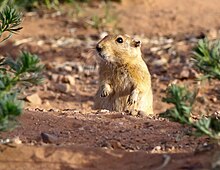Psammomys obesus
| Fat sand rat Temporal range: Late Miocene–Recent |
|
|---|---|
 |
|
| Scientific classification | |
| Kingdom: | Animalia |
| Phylum: | Chordata |
| Class: | Mammalia |
| Order: | Rodentia |
| Family: | Muridae |
| Subfamily: | Gerbillinae |
| Genus: | Psammomys |
| Species: | P. obesus |
| Binomial name | |
|
Psammomys obesus Cretzschmar, 1828 |
|
The fat sand rat (Psammomys obesus) is a terrestrial mammal from the gerbil subfamily that is mostly found in North Africa and the Middle East, ranging from Mauritania to the Arabian Peninsula.
This species usually lives in sandy deserts, but may also be found in rocky terrain or saline marsh areas. It lives in burrows, which are often located under the bushes in which the rats forage, such as salt bushes of the family Chenopodiaceae. The fat sand rat is diurnal, but its activity on the surface depends on the ambient temperature. The fat sand rat normally has two litters every year; each litter usually comprises three to seven pups.
Although they remain lean when fed their natural, vegetable-based diet, fat sand rats can easily become obese and acquire type 2 diabetes mellitus when they are fed a normal rodent diet of grains. Therefore, they have been used as an animal model for studies on diabetes and obesity.
Because they are diurnal, fat sand rats are also used as models for human seasonal affective disorder.
The presence of fat sand rats in North Africa and the Middle East is of healthcare importance, as this species can harbor the parasite which causes leishmaniasis in humans.
These animals have been studied extensively for their remarkably efficient kidneys: they can produce very concentrated urine which enables them to eat halophyte plants and survive extreme heat and lack of water in their desert habitat.
...
Wikipedia

